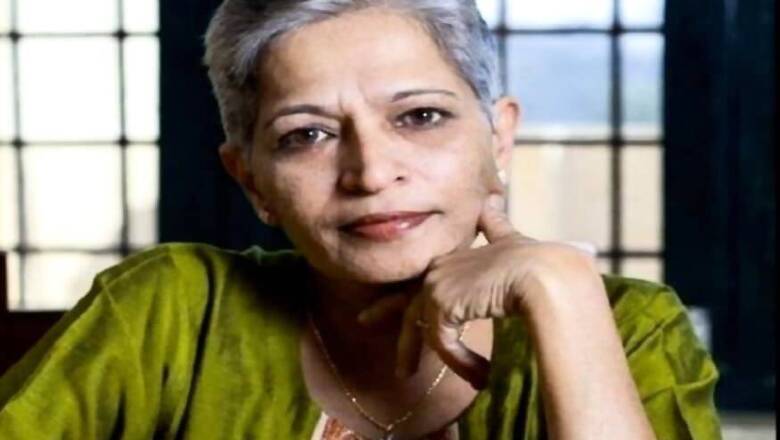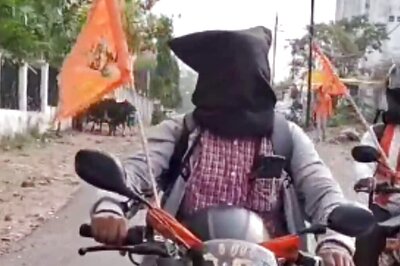
views
Bengaluru: The Special Investigation Team probing the murder of journalist and activist Gauri Lankesh has made its first breakthrough, taking into custody on Friday evening a 37-year-old man, who was earlier picked up in an illegal arms case.
The SIT’s Chief Investigating Officer Anucheth confirmed that they have arrested K T Naveen Kumar, taking his police custody for eight days for interrogation for possible involvement in the Lankesh murder.
Naveen, who hails from Birur, a small town in south Karnataka’s Chikkamagalur district, was picked up by the crime branch on February 19 from a busy bus station in Bengaluru for illegal possession of bullets of the same kind that were used in the killing of Lankesh. He will be questioned as a suspect in the Lankesh case now.
Fifty-five-year-old Lankesh was killed by two assailants as she returned home from work around 8 pm on the night of September 5, 2017, in a cold-blooded murder that shocked the city. She was shot four bullets at point-blank range, an attack that took merely a few seconds – but was caught on the CCTV cameras installed outside her home.
Lankesh was always known for her firebrand journalism in the running of her Kannada paper ‘Gauri Lankesh Patrike,’ her activism on many fronts and her outspokenness on any issue, rebelling against the powers that be – traits that could have provided motives for her killing, it is suspected.
The images at her home were themselves difficult to work upon – as there was no light that had been switched on in her home and the assailants who were seen riding a bike had also worn helmets that made identification problematic.
But artificial intelligence software developed by experts for specifically this case tracked down the fact that the same assailants had done a reconnaissance of the Lankesh home in west Bengaluru at least twice before the actual killing – once around 3 pm and again 7 pm, hours before she was killed, and at times when there was day-light.
It is this video evidence, along with some other statements by witnesses in the neighbourhood, that has led the SIT to suspect Naveen Kumar’s involvement in the case. SIT officials, however, remained tight-lipped on what exactly his role was in the murder – saying merely that he will be interrogated at this time.
Kumar is said to be affiliated with right-wing Hindu organizations, but in a knee-jerk reaction of sorts, within days of his arrest, the Hindu Rakshana Vedike in Karnataka put out a press release distancing itself from him.
“Naveen Kumar is not a member or worker of the Hindu Rakshana Vedike, and the Vedike has no link with him. The Vedike’s name is being dragged into this controversy unnecessarily and with malicious intent,” stated the release from KT Ullas, south Karnataka General Secretary of the Vedike.
SIT officials have not mentioned whether he is affiliated with any specific right-wing group, however, since many of these groups have no registered membership, it is quite easy to be anonymous in any of the organizations.
It is the weapons trail in the case that is more significant, though. Over the last six months since the SIT was formed, it has run down many leads on arms deals of country-made weapons across Karnataka, particularly in north Karnataka districts like Vijayapura.
It has identified the bullets that were pumped into Lankesh as one with a 7.65 mm bore.
Kumar had at least 15 such rounds of cartridges of the 0.32 calibre in his possession. In fact, his arrest by the Crime Branch are for offences under the Arms Act – specifically Section 3 (possession of arms and ammunition without a licence) and Section 25 (which covers a range of offences from illegal trade of arms to tampering with firearms to violating other provisions of the Act).
But it is not just this solo arrest that will be significant in coming weeks. What has been established by ballistic experts so far is a direct link between the Lankesh murder and the murder of other rationalists and activists in Karnataka and Maharashtra. Prof MM Kalburgi, a well-known academic and former Vice Chancellor, was killed outside his home in Dharwad in north Karnataka, in a similar modus operandi as Lankesh, in August 2015.
Bullets used in the Lankesh and Kalburgi both match – which point to the same weapon used.
More significantly, six months prior to the Kalburgi killing, rationalist Govind Pansare was killed in Mumbai in Maharashtra with bullets being pumped from two guns – some of these bullets match the ones used in the Lankesh and Kalburgi murders. And interestingly, the bullets from the second gun that shot at Pansare match the bullets used to kill another rationalist and anti-superstition activist Narendra Dabholkar in Maharashtra’s Pune in 2013.
The inter-twining of the ballistic evidence could help in cracking down on all the cases – especially since the modus operandi of two bike-borne gunmen accosting the victims and shooting them at point-blank range is also another pattern that runs through.
The other commonality is that they were all shot for their rationalist thoughts and activism
Since these murders are all being probed by four different agencies – the SIT for Lankesh, the Karnataka CID for Kalburgi, the Maharashtra police probing Pansare’s murder and the Central Bureau of Investigation is probing the Dabholkar killing – the coordination between the different investigations could well take longer.
But in all this, the ballistic evidence could be the most crucial.




















Comments
0 comment